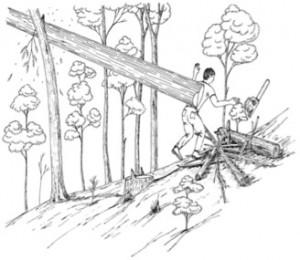BACKGROUND: A timber cutter was felling a 20-inch-diameter, 100-foot-tall poplar on a 40 percent slope on a summer day in the Appalachians.
PERSONAL CHARACTERISTICS: The 47-year-old timber cutter had been working as a logger for at least 20 years. He had apparently never attended any logging safety training programs. He was wearing chaps and boots but no hard hat, eye, or hearing protection. He had been cutting for three and a half hours prior to the incident.
UNSAFE ACTS AND CONDITIONS: The poplar was located eight feet downhill from a large pile of logging slash that obstructed the cutter’s escape path. He cut a notch to direct the poplar’s fall diagonally downhill. He also made a bore cut that left a small dog-eared hinge on two sides of the trunk. In line with the tree’s intended fall direction was a 60-foot, 18-inch-diameter walnut tree located 37 feet away from the poplar being felled. After making his final cut, the timber cutter retreated about 6 feet along the obstructed escape path uphill.
ACCIDENT: As the falling poplar contacted the walnut, the poplar’s trunk cantilevered into the air and swung towards the cutter, striking him and pinning him to the ground across his back.
INJURY: The dozer operator who witnessed the injury drove his pickup truck to the nearest house and called 911. By the time a volunteer fireman and EMS arrived approximately 20 minutes later, the timber cutter was dead. The medical examiner’s report listed the immediate cause of death as traumatic asphyxia and crushing chest injuries.
RECOMMENDATIONS FOR CORRECTION: Employers should develop, implement, and enforce the following company policies:
- Tree fellers shall prepare an unobstructed escape path and move a safe distance diagonally away from the tree’s intended direction of fall.
- Tree fellers shall identify or clear in advance an unobstructed fall path for the trees to be cut. This can prevent a tree from lodging against or glancing off other trees.
- Felling of timber by hand is prohibited when there is no suitable escape path or clear fall path.
- Timber cutters shall utilize proper directional felling techniques, including leaving an adequate hinge to guide the tree’s fall safely to the ground.
- Timber cutters must wear all OSHA-required personal protective equipment.
 Courtesy of the Forest Resources Association: https://www.forestresources.org/
Courtesy of the Forest Resources Association: https://www.forestresources.org/
